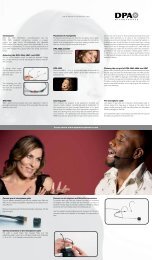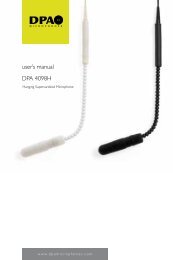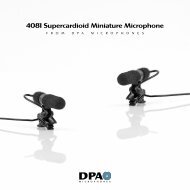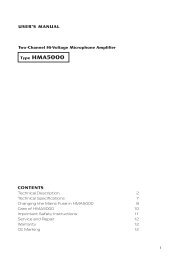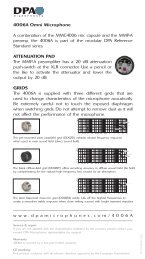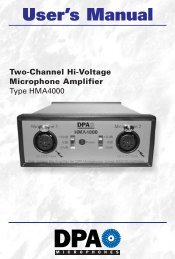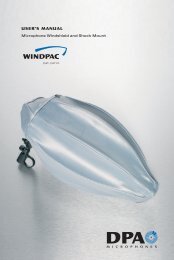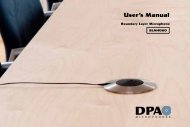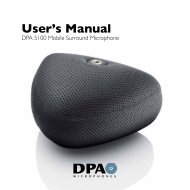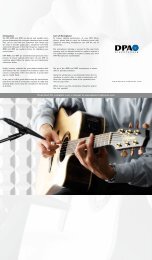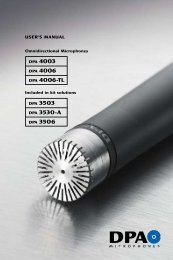The essentials of microphone technology â how ... - DPA Microphones
The essentials of microphone technology â how ... - DPA Microphones
The essentials of microphone technology â how ... - DPA Microphones
You also want an ePaper? Increase the reach of your titles
YUMPU automatically turns print PDFs into web optimized ePapers that Google loves.
Getting the right<br />
<strong>microphone</strong><br />
Before buying a <strong>microphone</strong>, it is essential to make sure<br />
that it will do the job you want it to do. This means that<br />
you have to clearly understand which application(s) the<br />
<strong>microphone</strong> was designed for.<br />
<strong>The</strong>re is no such thing as an all-purpose <strong>microphone</strong><br />
that is ideal for every application. Differences in pickup<br />
pattern, maximum SPL constraints and noise floor<br />
should all be taken into account during the selection<br />
process. All <strong>microphone</strong>s are made for a certain purpose<br />
or sometimes a compromise between several related<br />
purposes.<br />
Is it primarily for recording in a studio or home studio,<br />
is it for live use or perhaps both? Is it meant for one<br />
specific instrument or sound source or should it be for<br />
more general use? Is it to be mounted on a stand, an<br />
instrument, a head or is it handheld?<br />
Is your budget limited? Quality always costs. You can<br />
save money on features you don’t need, but to most<br />
people quality is a feature they do need.<br />
<strong>The</strong> main problem with a live setting is the large number<br />
<strong>of</strong> other loud sound sources other than the one you<br />
wish to amplify or record such as the P.A. front and the<br />
monitors that can cause feedback, or the other musicians<br />
and their amps that are <strong>of</strong>ten much louder than the<br />
voice or s<strong>of</strong>ter instrument you need to mic.<br />
This means that the primary objective for a live <strong>microphone</strong><br />
is separation and secondarily good <strong>of</strong>f-axis sound<br />
(sound taken in from the side/back <strong>of</strong> the <strong>microphone</strong>s).<br />
If the monitor and amplifier level on stage is controlled<br />
and relatively low, it is possible to gain more clarity and<br />
definition by using less directional <strong>microphone</strong>s.<br />
Dynamic vs.<br />
condenser mics<br />
Dynamic <strong>microphone</strong>s are, in brief terms, a reverse dynamic<br />
loudspeaker (you can actually use a loudspeaker<br />
as a dynamic mic – don’t try the opposite). It’s a moving<br />
coil in a permanent magnet. <strong>The</strong> diaphragm is attached<br />
to the coil, and when it moves, it produces varying current<br />
through electromagnetic induction.<br />
<strong>The</strong> construction <strong>of</strong> dynamic mics is quite simple, which<br />
makes them rugged and inexpensive and they don’t<br />
require external power. <strong>The</strong> rugged heavy construction<br />
also makes them more ‘forgiving’ with less resolution.<br />
Most common applications are live – especially on vocals,<br />
drums and amplifiers.<br />
A condenser <strong>microphone</strong> consists <strong>of</strong> a capacitor, where<br />
one side is the diaphragm and the other is the back<br />
plate which is polarized either from an external power<br />
source or by prepolarization. As the diaphragm moves<br />
it changes the capacitance, and these changes are then<br />
amplified to make a transmittable signal.<br />
Live vs. studio<br />
miking<br />
<strong>The</strong> main difference between these two environments is<br />
not the sound source itself but the surroundings.<br />
All condenser mics need external power (referred to as<br />
phantom power) to energize the internal electronics.<br />
<strong>The</strong>y produce a sound signal <strong>of</strong> a much higher quality<br />
than the dynamic mics, but they are more expensive,<br />
and a little more fragile to use, <strong>how</strong>ever newer <strong>technology</strong><br />
has made them far more resistant to rough use,<br />
and the use <strong>of</strong> condensers in live applications is on the<br />
rise.<br />
<strong>The</strong> studio is a relatively controlled environment, where<br />
you <strong>of</strong>ten are given a second chance if the result is not<br />
satisfactory. For that reason your expectations <strong>of</strong> the result<br />
will, <strong>of</strong> course, also be much higher. That means the desire<br />
for clarity, definition and low noise has no upper limit.<br />
In order to compensate for poor sounding acoustics or<br />
to get more channel separation when multiple instruments<br />
are recorded, directionality can be more important<br />
than definition and noise.<br />
<strong>The</strong> <strong>essentials</strong> <strong>of</strong> <strong>microphone</strong> <strong>technology</strong>: How to choose the right mic for the job




